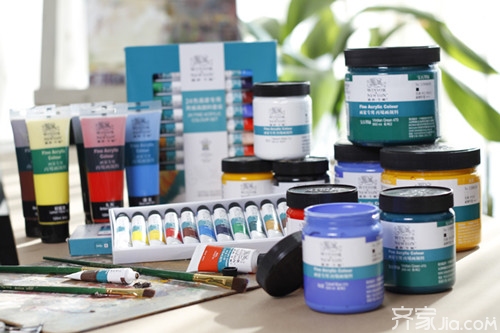For acrylic pigments, it is believed that many people have used them. Acrylic pigments belong to artificially synthesized polymeric pigments, which are made from pigment powder and acrylic latex. Acrylic latex contains acrylate, methacrylate, acrylic acid, methacrylic acid, as well as thickeners, fillers, and the like. The following small series describes how to wash acrylic paints and acrylic paints for everyone.

How to wash acrylic paint
Acrylic pigments are water-soluble and can be opened with water, but they have a water-repellent effect after drying and can be re-colored. Strong dry, strong adhesion, can be attached to any material such as glass, cloth, wood, etc. The wind and rain do not fade or peel off. Acrylic pigments are blended with water, so they dry faster and do not dissolve in water after drying. Propylene is an organic material. According to the characteristics of organic materials easily soluble in benzene, carbon tetrachloride, and alcohol, the clothes can be washed by dipping them in white wine or in medical alcohol and rubbed off. After it has dried, it can only be cleaned with industrial alcohol or acetone.
Because acrylic pigments are all organic, they should be careful not to touch organic solvents when washing, and some detergents containing enzymes should be used with caution. It is best to wash them by themselves. Use only a small amount of detergent and the time is not too long. The surfactant in the powder can cause the pigment to partially fall off. If acrylic paints are used for cloth painting, it is important for some skin-sensitive people because acrylic paints may cause some allergic reactions to your skin for a long time. Try to reduce the wearing time and avoid wearing it in sweaty situations. Of course, for skin-insensitive people, acrylic paint is the ideal hand-painted pigment for painted costumes and T-shirts. Most people use a little petrol to clean up. But that's not so easy to get.
Acrylic pigment properties
1, environmental protection - propylene is water-based pigments, water can be used to dilute, conducive to cleaning, without any odor.
2, quick-drying - Acrylic paint can be dried within minutes after the pen, do not have to wait for a few months to finish after the completion of the oil painting.
3. Waterproofing - The colored layer will quickly lose its solubility and form a tough, elastic, impermeable membrane.
4, color - acrylic color full, strong, fresh, no matter how to reconcile there will be no "dirty" and "gray" feeling. The colored layer will never have oil-absorbing stains.
5. Durability - the longevity of the work. The oil film in oil painting is easily oxidized for a long time. Yellowing and hardening make it easy to crack the screen. The acrylic film will never be brittle in theory, and it will never turn yellow.
6, adaptability - acrylic paint in the use of the biggest difference with the oil painting is the operation characteristics of the general water-based paint, both for watercolor, but also for gouache. Propylene-based ointment contains granules, and it is divided into coarse granules and fine granules, which provides convenience for making texture.

Is acrylic paint toxic?
Acrylic acid in acrylic pigments has a strong irritating effect on the skin, eyes and respiratory tract. Irritating to the respiratory tract, high concentrations of inhaled pulmonary edema. Anesthetic effect. Direct contact with the eyes can cause burns. The skin has obvious irritation and sensitization. Oral stimulation of the oral cavity and digestive tract may cause dizziness, difficulty breathing, and nervousness.
Methacrylic acid in acrylic pigments is a chemical additive with a pungent odor and its main use is for organic synthesis and polymer preparation. Irritating to nose and throat; high concentrations may cause lung changes. Irritating to skin, can cause burns. Eye contact can cause burns and permanent damage. May cause lung, liver and kidney damage for a long time. Sensitization to the skin, even after exposure to methacrylic acid, can cause skin irritation and rash.
The thickener in acrylic pigment is a food additive, which is mainly used to improve and increase the viscosity of food, maintain the color, aroma, taste and stability of fluid food and jelly food, improve the physical properties of food, and can Makes food feel lubricious and palatable. Thickeners can increase the viscosity of foods or form gels, thereby changing the physical properties of foods, giving foods a sticky, suitable taste, and emulsifying, stabilizing or suspending them. China is currently approved for use. There are 39 kinds of thickeners. Thickeners are hydrophilic polymers, also known as hydrosols.
Editor's summary: How to wash the acrylic pigment and the properties of the acrylic pigment are introduced here. I hope to be helpful to everyone. If you want to know more related information, you can pay attention to this website information.
How to do decoration budget budget with a loft How to decorate the decoration budget How to make a renovation loan How to apply
Faucets Accessories
Faucets accessories mainly include Bathroom Fittings like pop - up waste, Bottle Trap, Stainless Steel Flexible Hose, s – trap, P – trap, waste overflow with tailpiece etc. Otherwise, parts of faucet, like cartridge, handle, faucet shell, spout. People often look for these to do repair their broken faucets or any parts their assembly necessary.
Faucets Accessories
Faucets Accessories,Faucet Parts,Bathtub Faucet Parts,Shower Faucet Parts
SHENZHEN KING OF SUN INDUSTRY CO.,LTD , https://www.handyfaucet.com